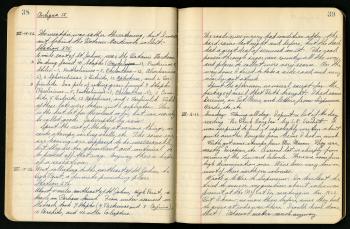
While occasionally a picnic area or table was used as a land-marker in scientific notes (like in paleobiologist G. Arthur Cooper’s, or in bird observations written by James W. Eike), stopping for a break to eat was often part of the day-to-day narratives of the field books.
For example, entomologist Richard Blackwelder often noted his favorite picnic spots while traveling for research (in the West Indies, it was High Point in St. Johns on the island of Antigua), or taking a Studebaker out with colleagues to find a picnic spot with a good view.
 The same was true for naturalist and collector David Crockett Graham, who emphasized the social aspect of a picnic outing. While collecting birds, insects, mammals, and reptiles throughout China in 1924, he mentions enjoying a “picnic supper” with his family on a hot August evening.
The same was true for naturalist and collector David Crockett Graham, who emphasized the social aspect of a picnic outing. While collecting birds, insects, mammals, and reptiles throughout China in 1924, he mentions enjoying a “picnic supper” with his family on a hot August evening.
For others, stopping for a picnic meant stopping to collect natural history specimens along the way. On National Zoo Director William Mann’s 1937 expedition to the Dutch East Indies, with his wife, Lucile, picnics were frequent. Often, the team would stop for a picnic by the side of the road, or by a pool or stream, as they trekked through the mountains. Lucile’s descriptions of the picnics offer a unique insight into the expedition’s travel conditions:
“At noon we were near another train into the same jungle, and stopped by the roadside to have a picnic lunch before we started working again. The only place where we could sit down off the road and out of the swamp, was a gravel pit, so there we sat, in the broiling heat, only a few miles from the Equator and almost at sea level, and wondered why so many of our tinned supplies and cheeses had gone bad. Anything that rides on the back of our car must be simply cooked and re-cooked long before we get it. We had our canteens filled, fortunately, and divided the drinking water. Also we had two coconuts to drink, for we were all more thirsty and hungry.”
The Mann expedition group often collected or observed species as they picnicked, as did the National History Museum’s Robert Gibbs, who took a lunch break while taking notes on dragonflies. After his picnic, he details an elaborate, 2.5 hour “chase” and triumphant capture of a dragonfly:
Now that you are ready for a lunch break, what do you pack? Take some sandwich inspiration from this menu from a Buenos Aires restaurant, visited by the Mann’s in 1939.

Related Resources
Where in the World Is That Field Book?, The Bigger Picture, Smithsonian Institution Archives
Scientific field work and food, Field Book Project
Smithsonian Institution Archives projects, Smithsonian Transcription Center
Produced by the Smithsonian Institution Archives. For copyright questions, please see the Terms of Use.

Leave a Comment